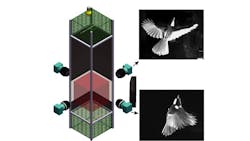High-Speed Cameras Help Determine Behavior Changes in Biologged Birds
Unterschleißheim, Germany—Biologging devices are widely used by scientists when studying animals in the wild. Since these devices collect data from moving animals in unprecedented ways, new doors have been opened to understanding animal behavior, ecology, and physiology. However, biologists have long been concerned that these devices, such as GPS tags, backpack microphones, proximity loggers, and depth loggers may impact animal movements and behavior because of their weight, and therefore subtly alter research results.
To address this issue, the Department of Animal Ecology in the Netherlands Institute of Ecology (Wageningen, Netherlands) used cameras from Mikrotron to document how various types of radio-tags affect the escape-flight performance of wild-caught songbirds (Parus major), focusing particularly on whether or not these birds adapt their body mass or behavior over time to carrying the tag.
In each trial conducted by the researchers, a tagged bird would fly upward in a vertical flight tunnel from a collection box while being filmed using four synchronized Mikrotron EoSens Camera Link monochrome cameras. The cameras were set to record at 400 frames per second at a spatial resolution of 1020 × 1020 pixels with an exposure time of 1 ms. Infrared lights illuminated the recording area, whereas a 40-W incandescent light bulb illuminated the collection box. Otherwise, the experimental room was kept completely dark.
Related: CoaXPress Camera Used in High-Speed Human-Robot Collaboration System
Based on the stereoscopic video recordings, the researchers reconstructed three-dimensional flight trajectories that detected the flight speed and wingbeat frequency during the escape flight. The tagged bird's upward escape maneuvers were manually tracked using the DTLdv digitizing tool in MathWorks MATLAB software. In each recording, the beak of the bird was tracked from all four camera views, and the start of the downstroke of each wingbeat was established. Based on the downstroke data, the trajectory-average wingbeat frequency of the upward-flying bird was determined with the location of the beak used to estimate the escape-flight speed in each maneuver. These experiments were conducted over a 28-day period in an attempt to show if the birds were changing their behavior over time.
The video research concluded that a radio tag can significantly reduce the upward escape-flight speed in an escaping bird, and that during the test period these birds did not adjust their flight behavior or body mass to compensate for the effect of the tag. In fact, the opposite dynamics were observed as untagged birds increased their upward escape-flight speed over time faster than the tagged birds. This shows that adding a tag to a songbird can affect its flight maneuverability at least for 28 days.
In addition, researchers found that tagged birds may stay more under cover and thus avoid having to make complex flight maneuvers during social conflicts or predatory interactions, as well as adjust their foraging strategies or selection of food items. Effects depended on the mass and shape of the tag, the attachment method, the individual, the time of year, the ecological context, and the individual situation in which a bird is radio-tagged.
Learn more about Mikrotron cameras at www.mikrotron.de.
1. "Radio-tag-induced reduction in escape-flight performance" Barbara M. Tomotani, Florian T. Muijres, Bronwyn Johnston, Henk P. van der Jeugd, Marc Naguib (12 November 2021
